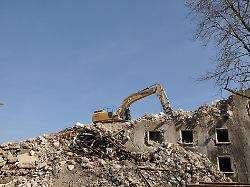Building demolitions are responsible for half of the waste in Germany and contribute significantly to the construction sector’s CO2 emissions. The new demolition atlas documents where and which buildings are being demolished – with the hope of bringing about a rethink in the industry.
The Palace of the Republic in Berlin was once one of the most famous buildings in Germany. The DRR Foreign Ministry was reflected in the glass front, and the Berlin television tower towered over the former seat of the East German parliament. A building from another time.
Today the Humboldt Forum stands at this location. The construction of the building took almost ten years. 100,000 cubic meters of concrete and 20,000 tons of steel were used for the building, as the Humboldt Forum Foundation itself states. An immense ecological footprint that could possibly have been reduced by renovating the old GDR building.
The building on Marx-Engels-Platz in Berlin is just one example of many. According to estimates by German Environmental Aid, 14,000 buildings are demolished in Germany every year. Including the new buildings on these areas, around one million tonnes of Co2 emissions are released. Since a large proportion of demolitions do not require permits, these numbers could be much higher.
Climate goals against housing
The building sector has been a problem for years in achieving Germany’s climate goals. In 2022, 112 million tons of greenhouse gases were emitted in the building sector. Only the transport sector caused more emissions. In order to achieve the climate goals by 2030, the building sector would have to emit 5.5 million tonnes of CO2 less per year.
At the same time, there is an estimated shortage of around 700,000 apartments in Germany. At the weekend, the federal government decided on a 14-point plan to promote and stimulate new construction. The Chancellor spoke of serial construction. Now construction projects are to be supported through tax advantages, environmental standards are to be lowered and ownership support for families is to be expanded.
However, there were no plans for the renovation of existing buildings. Mandatory renovations of individual residential buildings? Rejected. A program for the purchase of houses in need of renovation? Comes in two years at the earliest. “You managed to clear away all climate targets in just one weekend,” said Barbara Metz, federal managing director of German Environmental Aid (DUH), at a press conference about a new project on building demolitions in Germany.
With the new demolition atlas All buildings that are threatened with demolition – or have already been destroyed – should be recorded. The broad alliance of architectural, cultural and environmental associations is certain: “We are tearing down too much in Germany,” says Matthias Walter from the DUH at the online event. “The issue has not yet been addressed in the industry or in politics.”
Demolishing a new building cheaper than renovating?
Possibly because the costs for a new building to be demolished are often lower than for a complete renovation. But that could soon change. The costs for new buildings have risen rapidly since the beginning of the pandemic. The construction price index for residential buildings increased by 41 percent from 2010 to 2021. In May of this year, housing prices were almost 9 percent higher than in May 2022.
A 2022 study by the Wuppertal Institute for Climate, Environment and Energy shows that renovation is not always more expensive than demolishing new buildings. In addition, more funds are released for new construction, which often distorts the cost comparison of the two options.
Alexander Stumm, architect and professor at the University of Kassel, sees another reason for the price difference between renovation and new construction: “Because the costs are outsourced to the climate and the environment,” explains the co-organizer of the demolition moratorium initiative, in a letter to Building Minister Klara Geywitz calling for a stop to demolition of buildings in Germany.
The question about the cost differences between new construction and renovation is justified, says Tim Rieniets, architect and professor at Leibniz University Hannover. But it has to be answered differently than simply building more. For example, by adapting the restructuring regulations. Building regulations often stand in the way of renovation projects because the requirements are too high and the costs are driven up. “We have to ensure that renovating and maintaining is cheaper than building new,” says Rieniets.
However, existing buildings cannot always be converted for the new purpose. The Palace of the Republic was closed 13 years before it was demolished and stood empty due to emissions of carcinogenic asbestos fibers. Furthermore, plans for a museum might not have fit into an old parliament.
But if Germany wants to achieve its climate goals, the construction sector must follow suit. More than 220 million tons of construction waste are generated every year. Over 50 percent of waste in Germany is caused by the demolition of buildings. In Hanover, students thought about how this amount could be reduced. Their ideas will be presented in an exhibition in Hanover – in an old, empty department store that is threatened with demolition.
